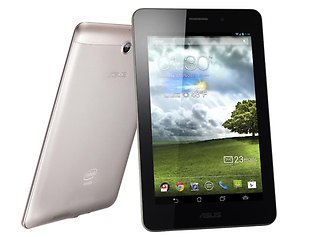
TAIPEI manufacturer Asus is getting a reputation for eccentricity.
Recently it released the Transformer AiO all-in-one computer with an 18.4-inch LED tablet of genetically modified proportions.
Some time back there was the Padfone, a smartphone that you clip into the back of a 10-inch shell that springs it to life as a fully sized tablet computer.
Now they've hit us between the eyes again with a 7-inch "phablet", an in-between sized mobile device that is both a phone and tablet computer, and aptly named the "Fonepad" so you can't confuse it with the "Padfone". Get that?
As a phone, making calls with it against your face while holding it stably is impractical, and looks freakish. You'll be the talk of the carriage on the 5.02pm train going home if you do.
GRAPHIC: Pros and cons
At a stretch, it can fit some front-trouser and jacket pockets, but put it in a back jeans pocket and it will either be picked, fall out or smash when you sit on it. It is more comfortable carried in a handbag or backpack.
VIDEO: A tablet and a phone
It makes more sense to think of the Fonepad as a dedicated 7-inch tablet that you use for calling with a headset or in speaker mode, with it plonked on your lap or desktop.
The inclusion of a 1.2-megapixel front-facing camera on Australian models means it can be used for videoconferencing and Skyping.
There's a sliding panel at the top that you take off to slot in a SIM card or micro SD card. I found it somewhat hard to remove the panel, but it is a neat solution - better than having to insert these items underneath batteries in some devices or into ports along the edge concealed by often-fragile plastic flaps.
Put phone functionality aside, and you have a very usable 7-inch tablet that competes with the Google's Nexus 7 released last year, and also made by Asus.
The two have a lot in common: both have 1280 x 800 pixel 7-inch displays, both with 216 pixels-per-inch screen resolution. Both have almost the same dimensions, both weigh 340g and both use Android 4.1 Jellybean.
There are differences. The Nexus 7 doesn't have phone functionality or a microSD slot to extend memory, and uses unadulterated Android 4.1 Jelly Bean.
The Fonepad uses close to vanilla Android 4.1, too, but with a lot of Asus proprietary apps thrown in. They include Asus "Splendid", a splendidly named app for tweaking your screen settings, and App Locker, a useful app for password protecting selected Android applications in case the phone falls into the wrong hands. Or the smaller hands of your kids. Supernote Lite is Asus's answer to Samsung S-Note, but there's no stylus, just your finger tips.
Asus has added a fourth soft-button to the usual back button, home and display apps Android trio-offering. The fourth button pops up a selection of eight applications that can run in a window above a primary app you are using.
For example, you can watch videos while reading. It's a feature that's becoming common, with Samsung and Huawei among brands already using it.
Instead of adopting the Nvidia Tegra 3 quad core 1.2 Gigahertz chipset used with the Nexus 7, Asus this time went for a single core Intel Atom system-on-a-chip running at 1.2 or 1.6GHz, in 8 Gigabyte or 64GB storage models respectively. The tablet performed pretty smoothly with Intel Atom despite the single core architecture, although not with the blistering speed of high-end tablets that cost double the price.
Australian Fonepad models also have a three-megapixel back-facing camera. Photos look clear enough on the 7-inch screen, but on a bigger displays seem pretty granular. Zoom in on a photo and you'll see what I mean.
The camera is limited to 720p recording rather than 1080p full high-definition video. These are yesteryear specs, but this is a cheap tablet. There is no back-facing camera on the Nexus 7.
The Fonepad has a decent 4720 Li-polymer milliampere Hour battery so getting through the day shouldn't be a problem.
With its aluminium back plate and classy finish, the Fonepad is an attractive, relatively cheap tablet with solid, but far from cutting edge, specs.
It's more expensive than the Nexus 7, but it adds a SIM card and microSD card and back-facing camera, all of which the Nexus 7 doesn't have.





